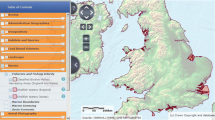Abstract
A theoretical model linking the production of salmon, mussels and seaweed in floating, enclosed units is based on field data, laboratory tests and literature data. First step is the production of 300 metric tons of salmon in 12 production units of 500 m3 each and a total water flow of 60 m3 min−1. Using a standard high energy dry feed with a feed conversion factor of 1, a production of 300 metric tons of salmon is calculated to produce 15 metric tons of nitrogen (N) and 2.4 metric tons of phosphate (P), of which 13 metric tons of N and 0.7 metric tons of P are dissolved. Outlet water is transferred from the salmon units to 12 closed units (500 m3 each) with blue mussels. A standing stock of 112.5 metric tons of mussels (WW) is necessary to filtrate 60 m3 min−1. If all particles are filtrated through the mussels, 25% of the nitrogen is accumulated as increased biomass. 25–30% is released as faeces and 45–50% as dissolved matter. Particles are removed by a sedimentation trap. Outlet water from the 12 mussel filter units, containing 13.9 metric tons of dissolved N (0.9 metric tons from the mussels), is transferred to closed units (1000 m3) with seaweeds. Concentration of N is calculated to 0.44 g N m−3 and hydraulic retention time in the seaweed production unit is 4 hours. With a DW of 20% (4% N of DW) and an estimated growth rate of 10% d−1 during the production period, a standing stock of 45 metric tons (FW) of seaweed is theoretically needed to bind up all dissolved N from the salmon and mussel production.
Similar content being viewed by others
References
Bodvin, T., 1992. Lukkede anlegg. Muligheter for bruk av teknologi for optimal drift og reduserte avløpsmengder. Vann 4: 616–620. (In Norwegian.)
Bodvin, T., M. Indergaard, E. Norgaard, A. Jensen & A. Skaar, 1994. ‘Det miljøvennlige havbruk’ som satsningsområde for regionalt næringsliv, forskning og høgskoleundervisning. Agder Research Foundation, sluttrapport. 55 pp. (In Norwegian.)
Bodvin, T. & E. Norgaard, 1993. Det miljøvennlige havbruk der vann er katalytt. Agder Research Foundation, sluttrapport. 29 pp. (In Norwegian.)
Bodvin, T. & Y. Ulgenes, 1994. Tilpasning, testing og demonstrasjon av oppsamlingssystemer for flytende, lukkede oppdrettsanlegg. SFT-prosjekt nr. 93620, delrapport. 13 pp. (In Norwegian.)
Braaten, B. & P. Hovgaard, 1980. Veiledning i blåskjelldyrking på Vestlandet. Fisken og Havet, Serie B (1), 49 pp. (In Norwegian.)
Buschmann, A., O. A. Mora, P. Gómez, M. Böttger, S. Buitano, C. Retamales, P. A. Vergara & A. Gutierrez, 1994. Gracilaria chilensis outdoor tank cultivation in Chile: Use of land-based salmon culture effluents. Aquacult. Engineering 13: 283–300.
Coutteau, P. & P. Sorgeloos, 1993. Substitute diets for live algae in the intensive rearing of bivalve mollusks — a state of the an report. World Aquacult. 24: 45–52.
Haamer, J. & L. Edebo, 1990. Restaurering av ett näringsbelastat fjordsystem i centrala Bohuslän med hjälp av musselodlingar. Oceanografiska institusjonen, Göteborg universitetet. Röda serien nr 15, 1990. 32 pp. (In Swedish.)
Hopkins, J. S., R. D. Hamilton II, P. A. Sandifer & C. L. Browdy, 1993. The production of bivalve mollusks in intensive shrimp ponds and their effect on shrimp production and water quality. World Aquacult. 24: 74–77.
Indergaard, M. & A. Jensen, 1981. Nitrate and phosphate uptake in small populations of Laminaria digitata (Phaeophyceae). In T. Levring, (ed.) Proc. Xth Int. Seaweed Symp.: 411–419. Berlin: Walter de Gruyter.
Indergaard, M. & A. Jensen, 1991. Utnyttelse av marin biomasse. Trondheim: Institutt for bioteknologi, NTH (Norwegian Institute of Technology). 123 pp. (In Norwegian.)
Kwei lin, C., P. Ruamthaveesub & P. Wanuchsoontom, 1993. Integrated culture of the green mussel (Perna viridis) in waste water from an intensive shrimp pond: concept and practice. World Aquacult. 24: 68–73.
Lignell, Å., Ekman, P. & M. Pedersén, 1987. Cultivation technique for marine seaweeds allowing controlled and optimized conditions in the laboratory and on a pilot scale. Bot. Mar. 30: 417–424.
Shpigel, M., A. Neori, D.M. Popper & H. Gordin, 1993. A proposed model for ‘environmentally clean’ land-based culture for fish, bivalves and seaweeds. Aquacult. 117: 115–128.
Skaar, A. & T. Bodvin, 1992. Driftsoptimalisering av flytende, lukkede oppdrettsanlegg. Sluttrapport NTNF-prosjekt HB 1901 26090. 44 pp. (In Norwegian.)
Skaar, A. & T. Bodvin, 1993. Full-scale production of salmon in floating, closed systems. In H. Reinertsen, L. A. Dahle, L. Jorgensen & K. Tvinnerim (eds), Proceedings of the first international conference of fishfarming technology, Trondheim, 9–12. august 1993, pp. 325–329. Rotterdam: Balkema.
Skaar, A., A. Kittelsen, T. Refsti, K. Steinshylla & T. Bodvin, 1994. Miljøanalyse og driftserfaringer for lukket oppdrettsanlegg i sjø. Sluttrapport SFT-prosjekt 93390. 45 pp. (In Norwegian.)
Tvinnereim, K. (ed) 1992. Temautgave: Lukkede produksjonsanlegg. Norsk Fiskeoppdrett 1A, 65 pp. (In Norwegian.)
Author information
Authors and Affiliations
Rights and permissions
About this article
Cite this article
Bodvin, T., Indergaard, M., Norgaard, E. et al. Clean technology in aquaculture — a production without waste products?. Hydrobiologia 326, 83–86 (1996). https://doi.org/10.1007/BF00047790
Issue Date:
DOI: https://doi.org/10.1007/BF00047790




